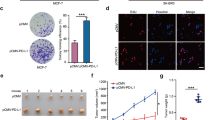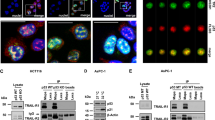Abstract
Aberrant DNA methylation of promoter region CpG islands is associated with gene silencing and serves as an alternative to mutations in the inactivation of tumor suppressor genes in human cancers. We identified a gene TMS1 (for Target of Methylation-mediated Silencing) that is subject to such epigenetic silencing in a significant proportion of human breast and other cancers. Also known as ASC and PYCARD, TMS1 encodes a bipartite intracellular signaling molecule with proposed roles in apoptosis and inflammation. However, the precise role of this protein in the pathogenesis of breast and other cancers has not been clearly defined. In this study, we examined the role of TMS1/ASC in death receptor signaling. We found that TMS1/ASC is upregulated in response to treatment with TNF-related apoptosis-inducing ligand (TRAIL) and tumor necrosis factor-α (TNFα) in breast epithelial cells, but not in human fibroblasts. This upregulation was not dependent on the synthesis of a TNFα-regulated intermediate or alterations in mRNA stability, suggesting a direct effect on TMS1/ASC transcription. Induction of TMS1/ASC by TNFα was blocked by co-expression of a dominant negative IκBα, small interfering RNA-mediated knockdown of RelA/p65, or concurrent treatment with SP600125, indicating a requirement for the nuclear factor-κB (NF-κB) and jun kinase signaling pathways. Although previous work has suggested that TMS1/ASC may be directly regulated by p53, we found that whereas treatment of breast epithelial cells or normal diploid fibroblasts with DNA damaging agents resulted in the stabilization of endogenous p53 and a concomitant increase in p21, it had little impact on the expression of TMS1/ASC mRNA or protein. We further show that whereas TMS1/ASC is not required for TNFα or TRAIL-induced activation of NF-κB or caspase-8, it can promote caspase-8 activation independently of death receptor–ligand interactions. Taken together, these data suggest that upregulation of TMS1/ASC by TNFα and subsequent activation of caspase-8 could function to amplify the apoptotic signal induced by death receptors in some cell types, including breast epithelial cells.
This is a preview of subscription content, access via your institution
Access options
Subscribe to this journal
Receive 50 print issues and online access
$259.00 per year
only $5.18 per issue
Buy this article
- Purchase on Springer Link
- Instant access to full article PDF
Prices may be subject to local taxes which are calculated during checkout





Similar content being viewed by others
References
Ashkenazi A, Dixit VM . (1998). Science 281: 1305–1308.
Baeuerle PA, Baltimore D . (1996). Cell 87: 13–20.
Baldwin Jr AS . (1996). Annu Rev Immunol 14: 649–683.
Bennett BL, Sasaki DT, Murray BW, O’Leary EC, Sakata ST, Xu W et al. (2001). Proc Natl Acad Sci USA 98: 13681–13686.
Bird AP . (1986). Nature 321: 209–213.
Brockman JA, Scherer DC, McKinsey TA, Hall SM, Qi X, Lee WY et al. (1995). Mol Cell Biol 15: 2809–2818.
Conway KE, McConnell BB, Bowring CE, Donald CD, Warren ST, Vertino PM . (2000). Cancer Res 60: 6236–6242.
Chinnaiyan AM, Tepper CG, Seldin MF, O’Rourke K, Kischkel FC, Hellbardt S et al. (1996). J Biol Chem 271: 4961–4965.
Devin A, Cook A, Lin Y, Rodriguez Y, Kelliher M, Liu Z-G . (2000). Immunity 12: 419–429.
Furukawa Y, Sutheesophon K, Wada T, Nishimura M, Saito Y, Ishii H et al. (2005). Mol Cancer Res 3: 325–334.
Grenier JM, Wang L, Manji GA, Huang WJ, Al-Garawi A, Kelly R et al. (2002). FEBS Lett 530: 73–78.
Guan X, Sagara J, Yokoyama T, Koganehira Y, Oguchi M, Saida T et al. (2003). Int J Cancer 107: 202–208.
Harper N, Hughes M, MacFarlane M, Cohen GM . (2003). J Biol Chem 278: 25534–25541.
Hasegawa M, Imamura R, Kinoshita T, Matsumoto N, Masumoto J, Inohara N et al. (2005). J Biol Chem 280: 15122–15130.
Horak P, Pils D, Haller G, Pribill I, Roessler M, Tomek S et al. (2005). Mol Cancer Res 3: 335–343.
Hsu H, Shu HB, Pan MG, Goeddel DV . (1996). Cell 84: 299–308.
Jones PA, Baylin SB . (2002). Nat Rev Genet 3: 415–428.
Kasibhatla S, Brunner T, Genestier L, Echeverri F, Mahboubi A, Green DR . (1998). Mol Cell 1: 543–551.
Kasibhatla S, Tailor P, Bonefoy-Berard N, Mustelin T, Altman A, Fotedar A . (1999). Mol Cell Biol 19: 2021–2031.
Kelliher MA, Grimm S, Ishida Y, Kuo F, Stanger BZ, Leder P . (1998). Immunity 8: 297–303.
Kissel JL, Feinstein E, Cohen O, Jones PA, Tsai YC, Knowles MA et al. (1997). Oncogene 15: 403–407.
Laird PW . (2005). Hum Mol Genet 14 (S1): R65–R76.
Lander ES, Linton LM, Birren B, Nusbaum C, Zody MC, Baldwin J et al. (2001). Nature 409: 860–921.
Levine JJ, Stimson-Crider KM, Vertino PM . (2003). Oncogene 22: 3475–3488.
Li G, Xiang Y, Sabapathy K, Silverman RH . (2004). J Biol Chem 279: 1123–1131.
Lin Y, Devin A, Cook A, Keane MM, Kelliher M, Lipkowitz S et al. (2000). Mol Cell Biol 20: 6638–6645.
Manji GA, Wang L, Geddes BJ, Brown M, Merriam S, Al-Garawi A et al. (2002). J Biol Chem 277: 11570–11575.
Mariathasan S, Newton K, Monack DM, Vucic D, French DM, Lee WP et al. (2004). Nature 430: 213–218.
Martinon F, Burns K, Tschopp J . (2002). Mol Cell 10: 417–426.
Masumoto J, Dowds TA, Schaner P, Chen FF, Ogura Y, Li M et al. (2003). Biochem Biophys Res Commun 303: 69–73.
Masumoto J, Taniguchi S, Ayukawa K, Sarvotham H, Kishino T, Niikawa N et al. (1999). J Biol Chem 274: 33835–33838.
Masumoto J, Taniguchi Si, Nakayama J, Shiohara M, Hidaka E, Katsuyama T et al. (2001). J Histochem Cytochem 49: 1269–1276.
Mayo MW, Denlinger CE, Broad RM, Yeung F, Reilly ET, Shi Y et al. (2003). J Biol Chem 278: 18980–18989.
McConnell BB, Vertino PM . (2000). Cancer Res 60: 6243–6247.
McConnell BB, Vertino PM . (2004). Apoptosis 9: 5–18.
Micheau O, Tschopp J . (2003). Cell 114: 181–190.
Moriai R, Tsuji N, Kobayashi D, Yagihashi A, Namiki Y, Takahashi H et al. (2002). Anticancer Res 22: 4163–4168.
Muppidi JR, Tschopp J, Siegel RM . (2004). Immunity 21: 461–465.
Natoli G, Costanzo A, Ianni A, Templeton DJ, Woodgett JR, Balsano C et al. (1997). Science 275: 200–203.
Ohtsuka T, Ryu H, Minamishima YA, Macip S, Sagara J, Nakayama KI et al. (2004). Nat Cell Biol 6: 121–128.
Richards N, Schaner P, Diaz A, Stuckey J, Shelden E, Wadhwa A et al. (2001). J Biol Chem 276: 39320–39329.
Salvesen GS, Dixit VM . (1999). Proc Natl Acad Sci USA 96: 10964–10967.
Sharp DA, Lawrence DA, Ashkenazi A . (2005). J Biol Chem 280: 19401–19409.
Shaulian E, Schreiber M, Piu F, Beeche M, Wagner EF, Karin M . (2000). Cell 103: 897–907.
Shetty S, Graham BA, Brown JG, Hu X, Vegh-Yarema N, Harding G et al. (2005). Mol Cell Biol 25: 5404–5416.
Shi Y . (2004). Cell 117: 855–858.
Shiohara M, Taniguchi S, Masumoto J, Yasui K, Koike K, Komiyama A et al. (2002). Biochem Biophys Res Commun 293: 1314–1318.
Soengas MS, Capodieci P, Polsky D, Mora J, Esteller M, Opitz-Araya X et al. (2001). Nature 409: 207–211.
Srinivasula SM, Ahmad M, Fernandes-Alnemri T, Litwack G, Alnemri ES . (1996). Proc Natl Acad Sci USA 93: 14486–14491.
Stehlik C, Fiorentino L, Dorfleutner A, Bruey JM, Ariza EM, Sagara J et al. (2002). J Exp Med 196: 1605–1615.
Stehlik C, Lee SH, Dorfleutner A, Stassinopoulos A, Sagara J, Reed JC . (2003). J Immunol 171: 6154–6163.
Stone AR, Bobo W, Brat DJ, Devi NS, Van Meir EG, Vertino PM . (2004). Am J Pathol 165: 1151–1161.
Teitz T, Wei T, Valentine MB, Vanin EF, Grenet J, Valentine VA et al. (2000). Nat Med 6: 529–535.
Tewari M, Dixit VM . (1995). J Biol Chem 270: 3255–3260.
Tian B, Nowak DE, Jamaluddin M, Wang S, Brasier AR . (2005). J Biol Chem 280: 17435–17448.
Tournier C, Hess P, Yang DD, Xu J, Turner TK, Nimnual A et al. (2000). Science 288: 870–874.
van Noesel MM, van Bezouw S, Salomons GS, Voute PA, Pieters R, Baylin SB et al. (2002). Cancer Res 62: 2157–2161.
Virmani A, Rathi A, Sugio K, Sathyanarayana UG, Toyooka S, Kischel FC et al. (2003). Int J Cancer 106: 198–204.
Wajant H, Pfizenmaier K, Scheurich P . (2003). Cell Death Differ 10: 45–65.
Wang L, Manji GA, Grenier JM, Al-Garawi A, Merriam S, Lora JM et al. (2002). J Biol Chem 277: 29874–29880.
Webster GA, Perkins ND . (1999). Mol Cell Biol 19: 3485–3495.
Yamamoto M, Yaginuma K, Tsutsui H, Sagara J, Guan X, Seki E et al. (2004). Genes Cells 9: 1055–1067.
Yeh W-C, Shahinian A, Speiser D, Kraunus J, Billia F, Wakeham A et al. (1997). Immunity 7: 715–725.
Yokoyama T, Sagara J, Guan X, Masumoto J, Takeoka M, Komiyama Y et al. (2003). Cancer Lett 202: 101–108.
Yu JW, Wu J, Zhang Z, Datta P, Ibrahimi I, Taniguchi S et al. (2005). Cell Death Differ 13: 236–249.
Zhou A, Scoggin S, Gaynor RB, Williams NS . (2003). Oncogene 22: 2054–2064.
Acknowledgements
This work was supported by a Research Scholar Award to PMV from the American Cancer Society (RSG-02-144-01-CCG) and a predoctoral fellowship to MJP from the US Army Medical Research and Materiel Command Breast Cancer Research Program (DAMD-17-03-1-0578).
Author information
Authors and Affiliations
Corresponding author
Additional information
Supplementary Information accompanies the paper on the Oncogene website (http://www.nature.com/onc).
Supplementary information
Rights and permissions
About this article
Cite this article
Parsons, M., Vertino, P. Dual role of TMS1/ASC in death receptor signaling. Oncogene 25, 6948–6958 (2006). https://doi.org/10.1038/sj.onc.1209684
Received:
Revised:
Accepted:
Published:
Issue Date:
DOI: https://doi.org/10.1038/sj.onc.1209684
Keywords
This article is cited by
-
Combined low levels of H4K16ac and H4K20me3 predicts poor prognosis in breast cancer
International Journal of Clinical Oncology (2023)
-
ASC deficiency suppresses proliferation and prevents medulloblastoma incidence
Oncogene (2015)



